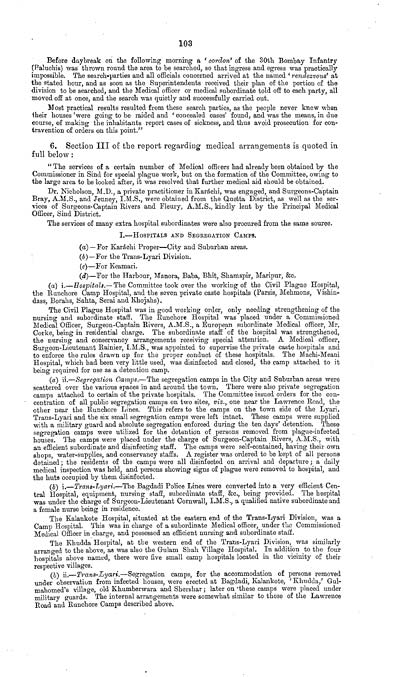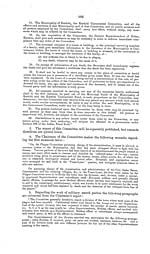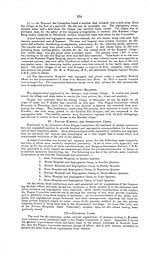Medicine - Disease > Account of plague administration in the Bombay Presidency from September 1896 till May 1897
(115) Page 103
Download files
Individual page:
Thumbnail gallery: Grid view | List view

103
Before daybreak on the following morning a 'cordon' of the 30th Bombay Infantry
(Baluchis) was thrown round the area to be searched, so that ingress and egress was practically
impossible. The search-parties and all officials concerned arrived at the named 'rendezvous' at
the stated hour, and as soon as the Superintendents received their plan of the portion of the
division to be searched, and the Medical officer or medical subordinate told off to each party, all
moved off at once, and the search was quietly and successfully carried out.
Most practical results resulted from these search parties, as the people never knew when
their houses 'were going to be raided and 'concealed cases' found, and was the means, in due
course, of making the inhabitants report cases of sickness, and thus avoid prosecution for con-
travention of orders on this point."
6. Section III of the report regarding medical arrangements is quoted in
full below:
"The services of a certain number of Medical officers had already been obtained by the
Commissioner in Sind for special plague work, but on the formation of the Committee, owing to
the large area to be looked after, it was resolved that further medical aid should be obtained.
Dr. Nicholson, M.D., a private practitioner in Karchi, was engaged, and Surgeons-Captain
Bray, A.M.S., and Jenney, I.M.S., were obtained from the Quetta District, as well as the ser-
vices of Surgeons-Captain Rivers and Fleury, A.M.S., kindly lent by the Principal Medical
Officer, Sind District.
The services of many extra hospital subordinates were also procured from the same source.
I.-HOSPITALS AND SEGREGATION CAMPS.
(a)-For Karchi Proper-City and Suburban areas.
(b)-For the Trans-Lyari Division.
(c)-For Keamari.
(d)-For the Harbour, Manora, Baba, Bhit, Shamspir, Maripur, &c.
(a) i.-Hospitals.-The Committee took over the working of the Civil Plague Hospital,
the Runchore Camp Hospital, and the seven private caste hospitals (Parsis, Mehmons, Vishin-
dass, Borahs, Sahta, Serai and Khojahs).
The Civil Plague Hospital was in good working order, only needing strengthening of the
nursing and subordinate staff. The Runchore Hospital was placed under a Commissioned
Medical Officer, Surgeon-Captain Rivers, A.M.S., a European subordinate Medical officer, Mr.
Corke, being in residential charge. The subordinate staff of the hospital was strengthened,
the nursing and conservancy arrangements receiving special attention. A Medical officer,
Surgeon-Lieutenant Rainier, I.M.S., was appointed to supervise the private caste hospitals and
to enforce the rules drawn up for the proper conduct of these hospitals. The Machi-Meani
Hospital, which had been very little used, was disinfected and closed, the camp attached to it
being required for use as a detention camp.
(a) ii.-Segregation Camps.-The segregation camps in the City and Suburban areas were
scattered over the various spaces in and around the town. There were also private segregation
camps attached to certain of the private hospitals. The Committee issued orders for the con-
centration of all public segregation camps on two sites, viz., one near the Lawrence Road, the
other near the Runchore Lines. This refers to the camps on the town side of the Lyari.
Traus-Lyari and the six small segregation camps were left intact. These camps were supplied
with a military guard and absolute segregation enforced during the ten days' detention. These
segregation camps were utilized for the detention of persons removed from plague-infected
houses. The camps were placed under the charge of Surgeon-Captain Rivers, A.M.S., with
an efficient subordinate and disinfecting staff. The camps were self-contained, having their own
shops, water-supplies, and conservancy staffs. A register was ordered to be kept of all persons
detained; the residents of the camps were all disinfected on arrival and departure; a daily
medical inspection was held, and persons showing signs of plague were removed to hospital, and
the huts occupied by them disinfected.
(b) i.-Trans-Lyari.-The Bagdadi Police Lines were converted into a very efficient Cen-
tral Hospital, equipment, nursing staff, subordinate staff, &c., being provided. The hospital
was under the charge of Surgeon-Lieutenant Cornwall, I.M.S., a qualified native subordinate and
a female nurse being in residence.
The Kalankote Hospital, situated at the eastern end of the Trans-Lyari Division, was a
Camp Hospital. This was in charge of a subordinate Medical officer, under the Commissioned
Medical Officer in charge, and possessed an efficient nursing and subordinate staff.
The Khudda Hospital, at the western end of the Trans-Lyari Division, was similarly
arranged to the above, as was also the Gulam Shah Village Hospital. In addition to the four
hospitals above named, there were five small camp hospitals located in the vicinity of their
respective villages.
(b) ii.-Trans-Lyari.-Segregation camps, for the accommodation of persons removed
under observation from infected houses, were erected at Bagdadi, Kalankote, 'Khudda,' Gul-
mahomed's village, old Khumberwara and Shershar; later on these camps were placed under
military guards. The internal arrangements were somewhat similar to those of the Lawrence
Road and Runchore Camps described above.
Before daybreak on the following morning a 'cordon' of the 30th Bombay Infantry
(Baluchis) was thrown round the area to be searched, so that ingress and egress was practically
impossible. The search-parties and all officials concerned arrived at the named 'rendezvous' at
the stated hour, and as soon as the Superintendents received their plan of the portion of the
division to be searched, and the Medical officer or medical subordinate told off to each party, all
moved off at once, and the search was quietly and successfully carried out.
Most practical results resulted from these search parties, as the people never knew when
their houses 'were going to be raided and 'concealed cases' found, and was the means, in due
course, of making the inhabitants report cases of sickness, and thus avoid prosecution for con-
travention of orders on this point."
6. Section III of the report regarding medical arrangements is quoted in
full below:
"The services of a certain number of Medical officers had already been obtained by the
Commissioner in Sind for special plague work, but on the formation of the Committee, owing to
the large area to be looked after, it was resolved that further medical aid should be obtained.
Dr. Nicholson, M.D., a private practitioner in Karchi, was engaged, and Surgeons-Captain
Bray, A.M.S., and Jenney, I.M.S., were obtained from the Quetta District, as well as the ser-
vices of Surgeons-Captain Rivers and Fleury, A.M.S., kindly lent by the Principal Medical
Officer, Sind District.
The services of many extra hospital subordinates were also procured from the same source.
I.-HOSPITALS AND SEGREGATION CAMPS.
(a)-For Karchi Proper-City and Suburban areas.
(b)-For the Trans-Lyari Division.
(c)-For Keamari.
(d)-For the Harbour, Manora, Baba, Bhit, Shamspir, Maripur, &c.
(a) i.-Hospitals.-The Committee took over the working of the Civil Plague Hospital,
the Runchore Camp Hospital, and the seven private caste hospitals (Parsis, Mehmons, Vishin-
dass, Borahs, Sahta, Serai and Khojahs).
The Civil Plague Hospital was in good working order, only needing strengthening of the
nursing and subordinate staff. The Runchore Hospital was placed under a Commissioned
Medical Officer, Surgeon-Captain Rivers, A.M.S., a European subordinate Medical officer, Mr.
Corke, being in residential charge. The subordinate staff of the hospital was strengthened,
the nursing and conservancy arrangements receiving special attention. A Medical officer,
Surgeon-Lieutenant Rainier, I.M.S., was appointed to supervise the private caste hospitals and
to enforce the rules drawn up for the proper conduct of these hospitals. The Machi-Meani
Hospital, which had been very little used, was disinfected and closed, the camp attached to it
being required for use as a detention camp.
(a) ii.-Segregation Camps.-The segregation camps in the City and Suburban areas were
scattered over the various spaces in and around the town. There were also private segregation
camps attached to certain of the private hospitals. The Committee issued orders for the con-
centration of all public segregation camps on two sites, viz., one near the Lawrence Road, the
other near the Runchore Lines. This refers to the camps on the town side of the Lyari.
Traus-Lyari and the six small segregation camps were left intact. These camps were supplied
with a military guard and absolute segregation enforced during the ten days' detention. These
segregation camps were utilized for the detention of persons removed from plague-infected
houses. The camps were placed under the charge of Surgeon-Captain Rivers, A.M.S., with
an efficient subordinate and disinfecting staff. The camps were self-contained, having their own
shops, water-supplies, and conservancy staffs. A register was ordered to be kept of all persons
detained; the residents of the camps were all disinfected on arrival and departure; a daily
medical inspection was held, and persons showing signs of plague were removed to hospital, and
the huts occupied by them disinfected.
(b) i.-Trans-Lyari.-The Bagdadi Police Lines were converted into a very efficient Cen-
tral Hospital, equipment, nursing staff, subordinate staff, &c., being provided. The hospital
was under the charge of Surgeon-Lieutenant Cornwall, I.M.S., a qualified native subordinate and
a female nurse being in residence.
The Kalankote Hospital, situated at the eastern end of the Trans-Lyari Division, was a
Camp Hospital. This was in charge of a subordinate Medical officer, under the Commissioned
Medical Officer in charge, and possessed an efficient nursing and subordinate staff.
The Khudda Hospital, at the western end of the Trans-Lyari Division, was similarly
arranged to the above, as was also the Gulam Shah Village Hospital. In addition to the four
hospitals above named, there were five small camp hospitals located in the vicinity of their
respective villages.
(b) ii.-Trans-Lyari.-Segregation camps, for the accommodation of persons removed
under observation from infected houses, were erected at Bagdadi, Kalankote, 'Khudda,' Gul-
mahomed's village, old Khumberwara and Shershar; later on these camps were placed under
military guards. The internal arrangements were somewhat similar to those of the Lawrence
Road and Runchore Camps described above.
Set display mode to: Large image | Zoom image | Transcription
Images and transcriptions on this page, including medium image downloads, may be used under the Creative Commons Attribution 4.0 International Licence unless otherwise stated. ![]()
| India Papers > Medicine - Disease > Account of plague administration in the Bombay Presidency from September 1896 till May 1897 > (115) Page 103 |
|---|
| Permanent URL | https://digital.nls.uk/74517240 |
|---|




